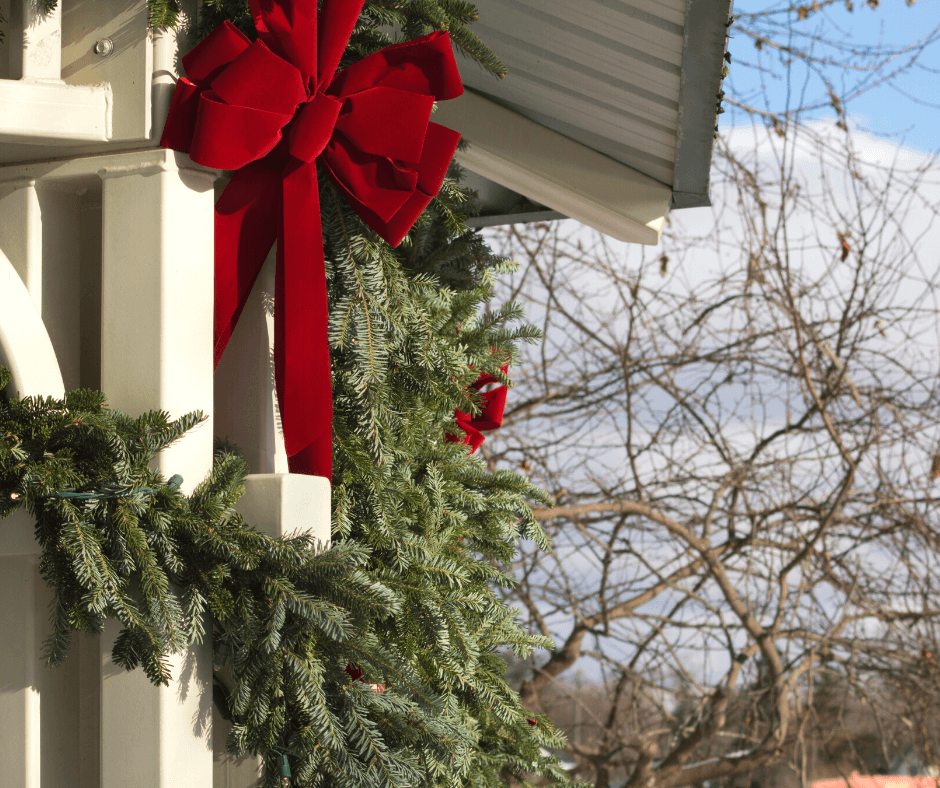What makes a holiday house plant great? It should be bright, colorful, and embody the spirit of the season. Here are our top ten favorite holiday house plants. Some continue to look good through much of winter!
Tag: Christmas
DIY Holiday Wreath from the Garden
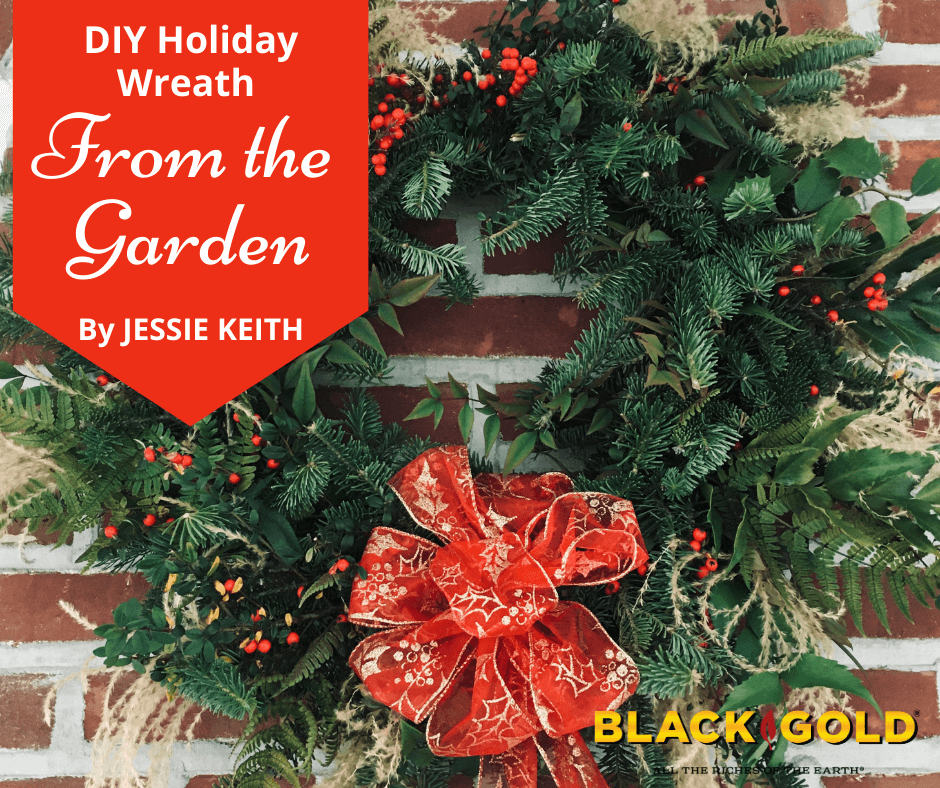
Homemade wreath making can be expensive if you invest in pricy greens, berried branches, premium pinecones, and premade bows and baubles. But, wreath making can also be inexpensive, which is especially welcome during tough economic times when money is tight. Harvest ornamental branches and clippings from the garden, ask your local tree-yard for free evergreen branches, and you can create outstanding wreaths for very little. Learn to make your own festive bows, and your wreath will be a little less than the final cost of a wreath frame, florist’s wire, ribbon, and a little elbow grease and creative inspiration.
I like to gather wreath materials from my garden and use trimmed branches from my Christmas tree, but not all readers may have this advantage. Thankfully, many tree yards offer inexpensive or free greens, cones, and other decorations for wreath-making. Garden centers also sell a variety of greens and berries–some pricy and some reasonable. It is easy to err on the frugal side and still have materials to create something pretty and testing. Either way, making your own wreath is far cheaper than purchasing pre-made wreaths, and you end up with custom-made creations with personality.

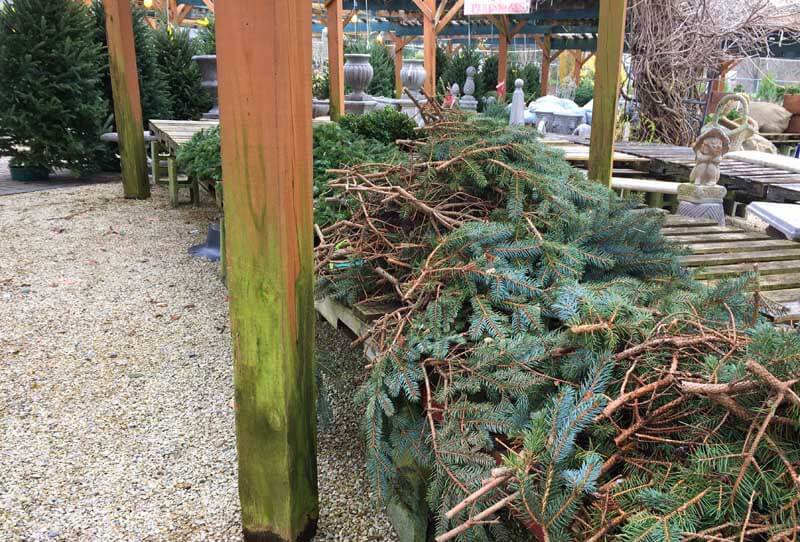
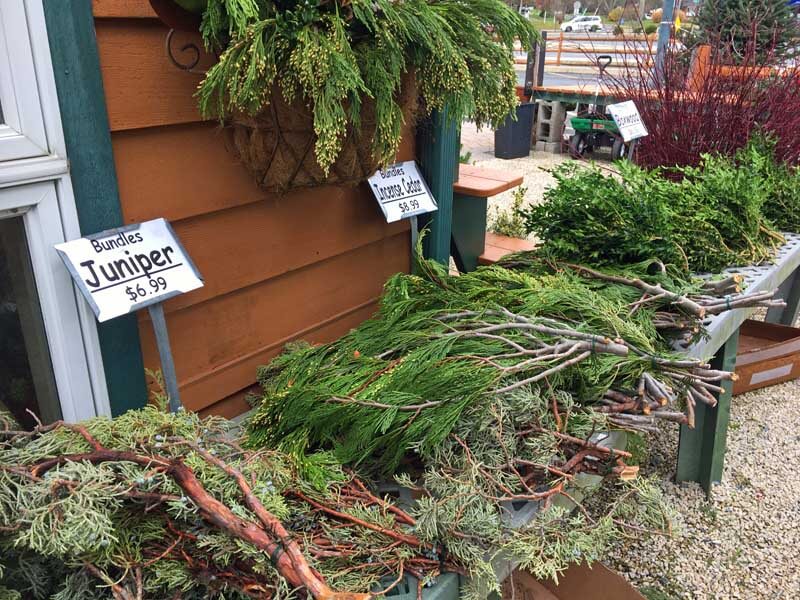
DIY Garden Wreath Components
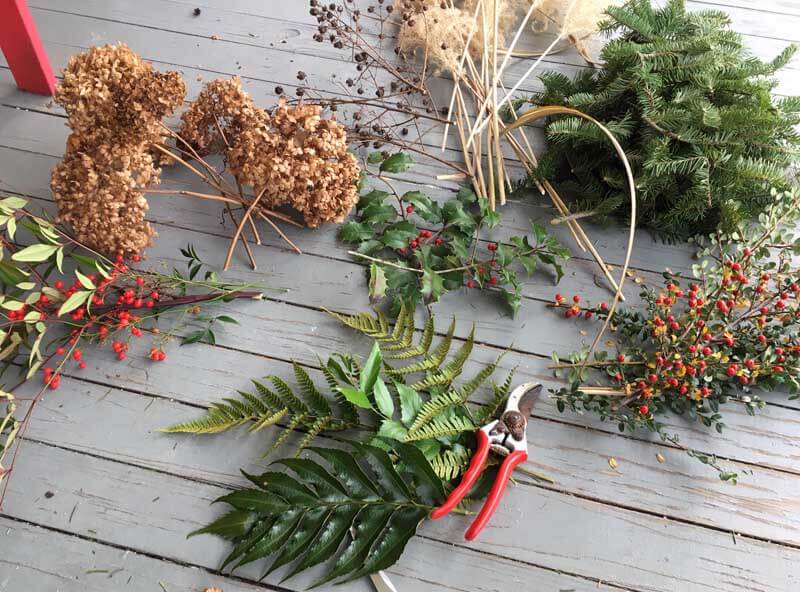
My favorite wreath components include evergreen branches, pine cones, dried flower heads, berried branches, dried grasses, and festive embellishments, such as metallic spray paint, a touch of glitter, and a bow. If I am feeling really frugal, I will even reuse a wreath frame by deconstructing my wreath creations yearly at the end of the season.
In addition to extra Frasier or balsam fir branches from my Chrismas trees, here are wreath components that I have in my yard:
- Evergreen Ferns
- Miscanthis Grass Plumes
- Dried Hydrangea Flowers (I did not add these to this year’s wreath)
- Nandina Greens & Berries
- American Holly Branches
- Cranberry Cotoneaster (Cotoneaster apiculatus) Branches/Berries
- White pine cones (I refrained from adding these to my wreath this year.)
Here are the extra materials I use for wreath making:
- Metal or grapevine wreath frame
- Heavy-duty shears
- A paddle of florist’s wire
- Decorative florist’s ribbon for the holidays or winter
DIY Wreath Technique
Here are the steps I took to put my wreath together. The process is easy, and the basic principles can be used to create lots of different wreath creations at different times of the year. Just be sure to use fresh plant materials that are long-lasting. Happy wreath making!
To make your porch look even more festive, make these holiday containers. They look wintery and pretty up until spring when you can dismantle them to make way for spring containers.
Beyond Poinsettias: Fresh Holiday House Plants
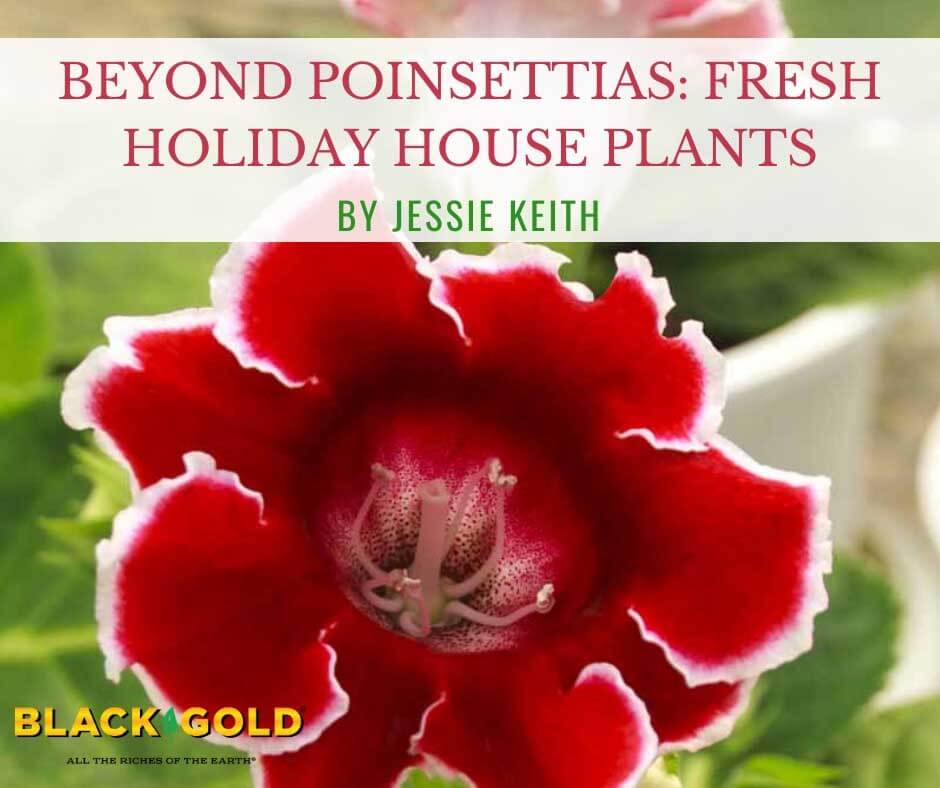
Red, green, and white–these are the common holiday colors. Poinsettias, amaryllis, paperwhites, and cyclamen–these are the common holiday plants in these colors. Why not shake it up? You can have these colors and enjoy them anew with more adventurous seasonal house plants.
Plant vendors sell all kinds of other indoor plants fit for the holidays and winter. It’s nice to include something new and just as festive but more exciting. Lots of cheery holiday plants also make long-lasting additions to the indoor garden, unlike most of the classics. (Click here to learn more about maintaining common holiday plants year-round.)
Holiday Flowering Plants
Red Guzmania (Guzmania hybrids)
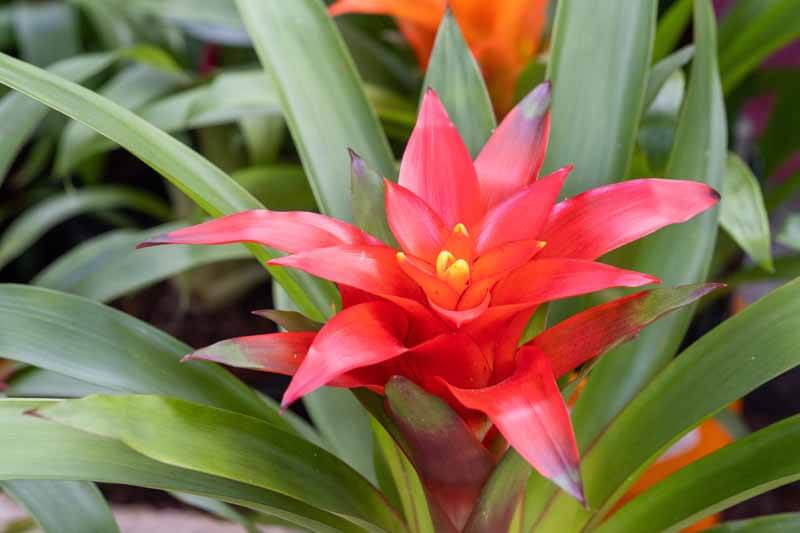
The floral and foliage characteristics of this tropical plant tick off all of the holiday boxes. Their blooms are starry, red, and festive, and they are supported by splays of glossy green foliage. There are many red guzmania varieties from which to choose, which have begun to appear more often for the holidays. Ambient humidity and warmth are important for the good health of this rain forest plant. Pot up red guzmania in a well-drained potting mix with high bark content, such as Black Gold Orchid Mix.
Anthurium (Anthurium spp.)
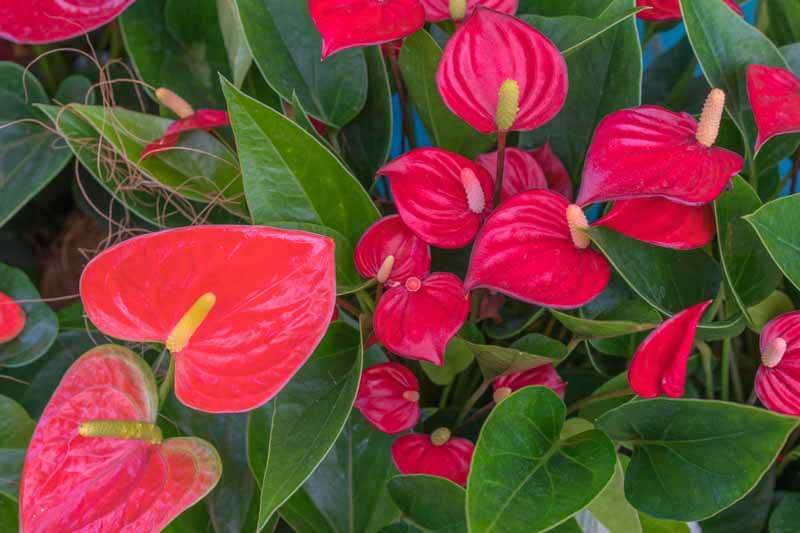
Glossy, bright red flowers make anthurium a real color contender with the traditional poinsettia. Its deep green leaves are also glossy. Choose cheery varieties for window-side tabletops or less sunny, north-facing windowsills.
Varieties may be tall or small. Large, bright red, heart-shaped flowers are the glory of ‘Queen of Hearts’, which reaches up to 2-feet. Anthurium ‘Million Flowers Red’ is a shorter red-flowered variety that produces extra-small flowers in large numbers. The cutest miniature, Anthurium ‘Baby White’, has little, white, petal-shaped blooms and only reaches 6-8 inches tall. Grab one of these, or another attractive variety, on your next trip to the garden center.
Rich, all-purpose potting soil, such as Black Gold All Purpose Potting Mix, high humidity, and warmth help anthurium bloom best. Wipe their leaves and long-blooming flowers off with a damp cloth every month or so to keep them clean and glossy.
White Jasmine (Jasminum polyanthum)

Let your winter evenings be filled with the floral scent of jasmine. The white tubular flowers appear in fall or early winter and smell nicer than paperwhites. It grows as a vine and needs some pruning and training so trim as needed. Place it in a spot with bright, indirect light, and provide it with good potting soil and regular water.
Christmas Kalanchoe (Kalanchoe blossfeldiana)

The English call this succulent Christmas kalanchoe because its bright flowers look radiant during the holidays. The compact plants have succulent leaves and reach between 6 to 18 inches. Popular varieties are red or white, but pink, orange, and yellow bloomers are also available. Flowering typically occurs from winter to spring but can last up to 6 months.
Like most succulents, kalanchoe needs little water during the winter months. It grows best in bright, sunlit, south-facing windows. Well-drained potting mix formulated for succulents, such as Black Gold Cactus Mix, is a must.
Florist’s Gloxinia (Sinningia speciosa)

Grow florist’s gloxinia as you would its close relative, the African violet, and transplant it into Black Gold African Violet Mix. (Click here to learn more about growing African violets (and gloxinia).)
Holiday Foliage Plants
When it comes to house plants with festive foliage, there are many to come by that will consistently look good all year. In summer, they can even be brought outdoors to liven up the patio.
Silver Queen Chinese Evergreen (Aglaonema ‘Silver Queen’)

The textural ‘Silver Queen’ has boldly marked leaves of white and green. The 1-2-foot lush plants are shade-loving and originate from the humid tropics and subtropics of Asia where they survive in the forest understory. Give them a good, water-holding potting mix like Black Gold® Waterhold Cocoblend Potting Mix.
Two Tone Moonstone Red Chinese Evergreen (Aglaonema ‘Two Tone Moonstone’)
Arguably the prettiest of the Aglaonema hybrids, ‘Two Tone Moonstone’ leaves are mottled with white and green and have pinkish-red stripes down each leaf. Grow it as you would ‘Silver Queen’.
T REX™ St. Nick Rex Begonia (Begonia T REX™ St. Nick)

Introduced by Terra Nova Nurseries, T REX™ St. Nick provides a whirlwind of color. Its large, toothed leaves are dark greenish-purple with specklings of pinkish-white and bold streaks of pink and red. Pink flowers bloom in fall. Lightly moist fertile potting soil (like our All-Purpose Potting Mix), average humidity, and filtered light will keep it happy. Be sure not to overwater it in winter.
Mammy Croton (Codiaeum ‘Mammy’)
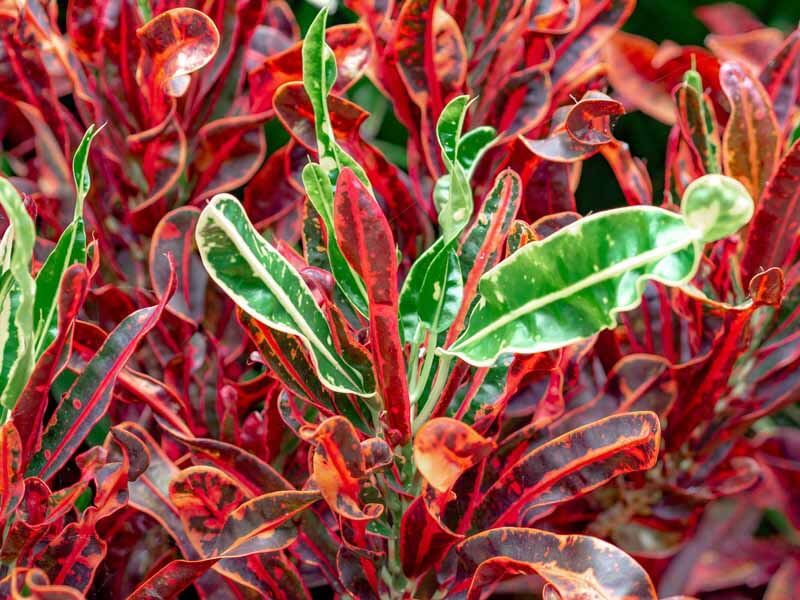
If you want a serious pop of color in your home, then grow the 2-3 foot croton ‘Mammy’. Its wavy, linear leaves are mottled with red, orange, and purple, and new growth is green and yellowish. Ironclad croton are very easy to grow if given large enough pots with well-drained potting soil (our Natural & Organic Potting Mix is a good choice), regular water, and average humidity. Wipe or rinse off the leaves from time to time to keep them dust-free.
Stay with the holiday color palette but break beyond the mold when it comes to holiday house plant choices. There are so many other jolly plants to enjoy through the season.
How Do I Keep My Evergreen Wreaths and Garlands from Drying Out?

“Every year at the holidays, I hang a live wreath and real pine garland on a fence outside near my patio. I’m wondering if you know of a way to preserve both the wreath and garland so that they last beyond the holiday season without getting brown? Thank you!” Question from Diane of Newark, Ohio
Answer: You have a couple of options, use either evergreen preservatives or foliage sealers. For preservatives, you can purchase one or make your own. Then there’s a matter of getting it into the wreath and/or garland branches. Liquid preservatives are easy to get into wreaths but next to impossible to get into long garlands unless the greens were preserved beforehand. For garlands, foliage sealer sprays are the better option, though they are a bit more expensive, especially if your garlands are long. Either way, here is an overview of different preservative products, application options, and suggestions for use.
Commercial and DIY Evergreen Preservatives
Chemical Tree Preservatives
There are many bottled commercial evergreen preservatives available. Look for them wherever cut trees are sold. There are also DIY recipes for evergreen preservatives that are said to be quite effective, though I have never tried one myself. Here is a DIY evergreen preservative recipe that I obtained from Live Science (click here). It provides clear step-by-step details. Keep in mind that all chemical options are toxic, so when using them, make sure pets or children cannot access the water. (Click here for additional safety instructions for evergreen preservatives.)
Wreath preservation: Shortly after purchasing your wreath, fill a broad utilitarian pan large enough to accommodate your wreath with the recommended preservative-to-water ratio. The pan should be filled with at least 2 inches of the mix–enough to cover the branch bases. Next, cut the branch bases with sharp pruners; this will allow the preservative to be taken up. Next, submerge the back of the wreath in the preservative mixture. Set the preserving wreath in a cool, dark place for at least a few days. Allow it to dry before hanging. This should help your wreath last longer outdoors. As a double precaution, you may also spray it with sealer.
Glycerin
It takes time to successfully treat evergreens with glycerine–two to three weeks–but if you have time, give it a try. Glycerine is non-toxic and available at craft centers. To make the mix, pour one part glycerin and two parts water into a pot. (The final quantity should be enough to submerge the back of your wreath in a pan.) Next, heat the mixture until it just reaches a boil, and then remove it from the heat. Let it cool, and store it in a cool, dark place until use.
Wreath preservation: Follow the same steps for chemical preservation using your glycerin mix, but keep your wreath in it for at least two weeks. After this time, the needles should be somewhat pliable. You’ll need more time for this method, so be sure to purchase wreaths in advance of the holidays. You can also cut evergreen stems, treat them with glycerine, and then make your own wreath. (Click here to see a great DIY wreath-making slide show by Martha Stewart.)
Spray Sealers
Clear foliage sealers are purchased as sprays and are perfect for helping preserve garlands. They keep needles from desiccating and add a glossy finish. There are also glittery ones if you like that sparkly look. Read the product instructions for the application.
Hopefully, one of these methods will work for you. As a final tip, for Christmas tree care I add sugared lemon-lime soda to the water. Adding a can to around a gallon of water will feed the tree and help keep the vascular tissue open for water uptake.
Happy holidays!
Jessie Keith
Black Gold Horticulturist
DIY Garden Project: Holiday Container Arrangement Decoration
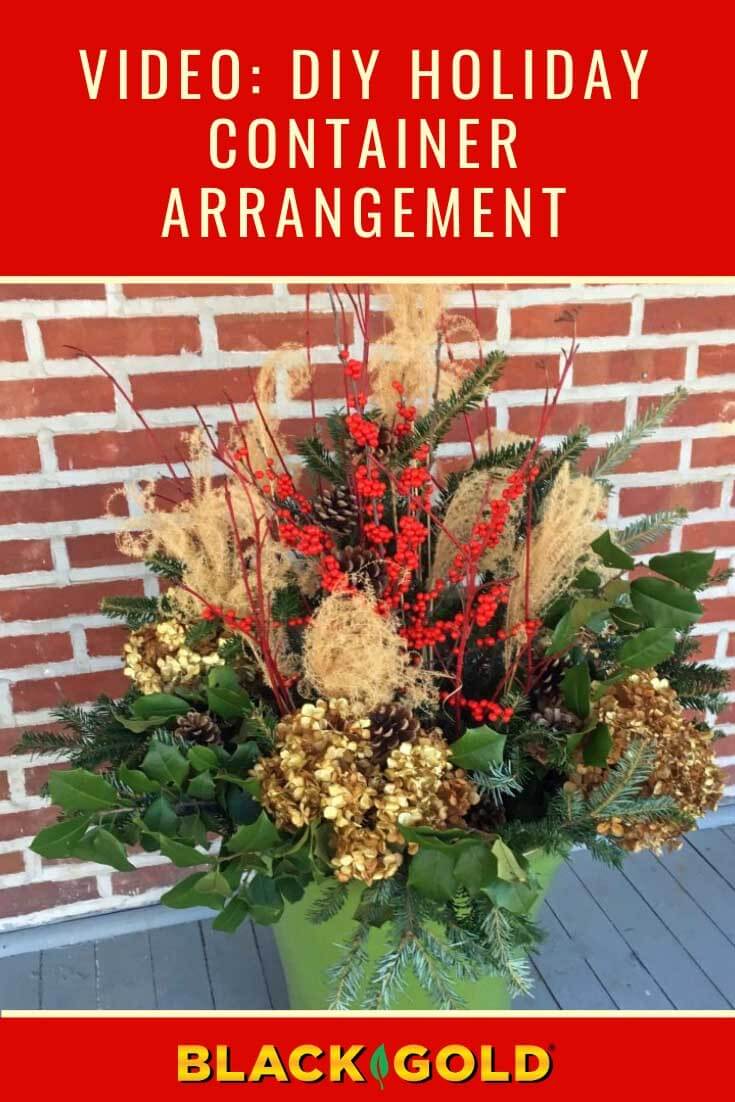
Don’t leave your patio ceramic containers empty during the holidays, Christmas, or winter! Fill them with beautiful evergreens, bright berried branches, and other festive outdoor decorations for a real front door showstopper.
Click here for a step-by-step pdf
Christmas Trees, Wreaths, Paperwhites
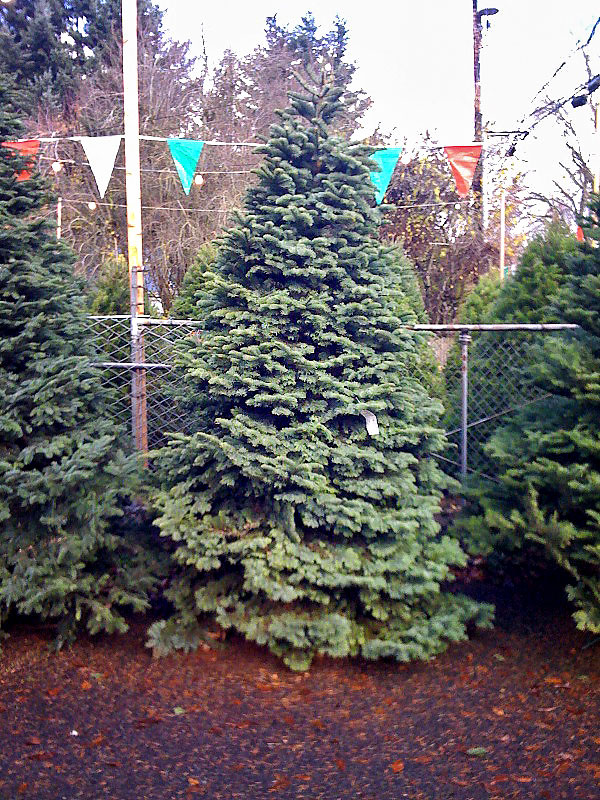 When buying a cut tree at a lot, keep in mind that the tree has probably been cut for several weeks and it could even be several months. When the tree is cut, it is a natural response for it to seal off the cut in order to conserve moisture. Since the butt end is sealed, it can only absorb a small amount of water, if any.
When buying a cut tree at a lot, keep in mind that the tree has probably been cut for several weeks and it could even be several months. When the tree is cut, it is a natural response for it to seal off the cut in order to conserve moisture. Since the butt end is sealed, it can only absorb a small amount of water, if any.
This is the reason it is so important to make a fresh cut of about an inch from the butt of the tree just before the tree is going to be taken indoors. Once this cut has been made, the tree should be placed in a bucket of fresh water or placed in the tree stand with fresh water. You may be amazed at how much water the tree will absorb especially during the first few days. Research that I have seen indicates that there is no need to add a preservative, fresh water works just fine. Check the water reservoir in the tree stand several times a day and refill as necessary. If the water level goes below the butt end of the tree, it will begin to seal itself up and this will prevent uptake of water. It is also a good idea to place your tree where it will not be getting warm air from a heater vent.
Living Christmas Tree
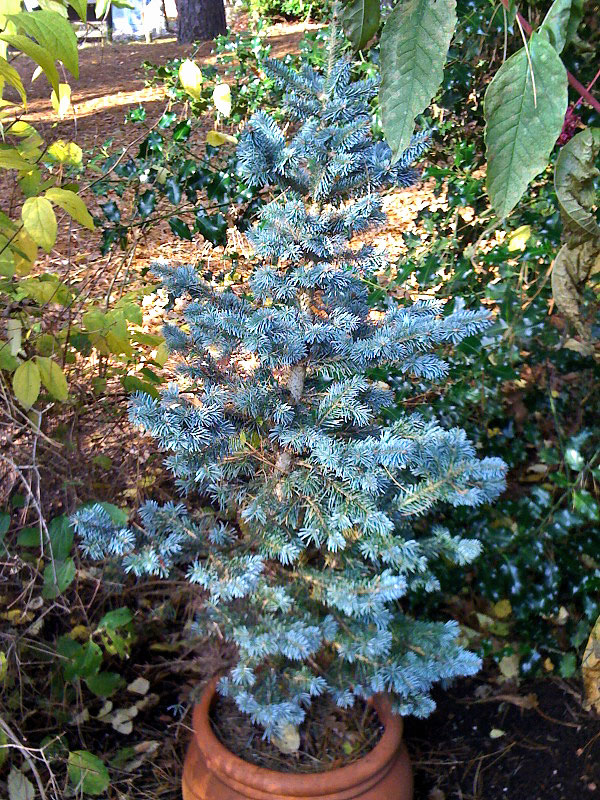 The term ‘living’ tree refers to a tree that is alive and growing and in a nursery container. This is in contrast to a ‘cut’ tree. Check out your local garden center for the varieties of living trees available. Growing in a container with soil, a living tree will be heavy to move around and since they will need to be watered, be sure to have a waterproof saucer under the container.
The term ‘living’ tree refers to a tree that is alive and growing and in a nursery container. This is in contrast to a ‘cut’ tree. Check out your local garden center for the varieties of living trees available. Growing in a container with soil, a living tree will be heavy to move around and since they will need to be watered, be sure to have a waterproof saucer under the container.Wreaths from the Garden
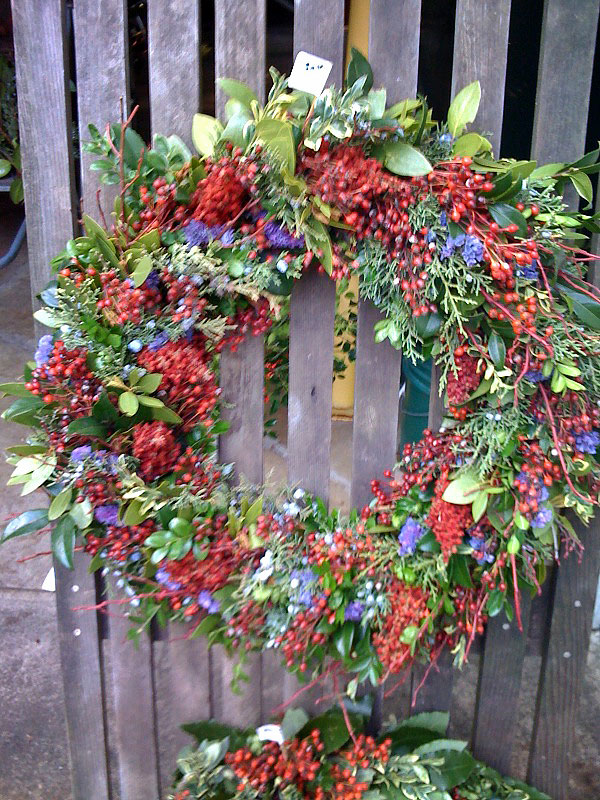 There are some wonderful wreaths being offered for sale, many with fresh material from local growers. If you have a supply of greenery, wreaths can be fun to make and give as gifts especially when the materials are from your garden. Fir, pine and holly are traditional, but consider adding something new.
There are some wonderful wreaths being offered for sale, many with fresh material from local growers. If you have a supply of greenery, wreaths can be fun to make and give as gifts especially when the materials are from your garden. Fir, pine and holly are traditional, but consider adding something new.Paperwhites
Paperwhite narcissus bulbs are very easy to force into bloom indoors. They will often bloom within 3-4 weeks of planting. All that is needed are healthy bulbs and some kind of dish or pot with no drainage. A traditional method is to put in a layer of gravel (many types available at garden centers especially for this purpose), place bulbs on top and bring water level just beneath the bulb. Place container by a window and keep water level constant.
One of the major drawbacks with forcing paperwhites is that they get tall and flop over. Some research from Cornell University indicates that by adding some ethyl alcohol will stunt the growth but you will still get the flowers. About a 5% (no stronger or it may burn plants) solution of ethyl alcohol is required, and so from a 40% distilled spirit such as gin, vodka, rum, etc, you would 1 part of the spirit and 7 parts of water. For this to work, add plain water as normal for the first week and then begin using the alcohol/water solution. Continue using this solution until the plants begin to bloom.
If you do not want to use ethyl alcohol you have for drinking, rubbing alcohol also works. It is about 70% alcohol so 1 part rubbing alcohol to 10-11 parts water would be appropriate. Do not use beer or wine as the sugars in them can cause some problems with plants. I tried this last year and it worked!
Enjoy the season!


